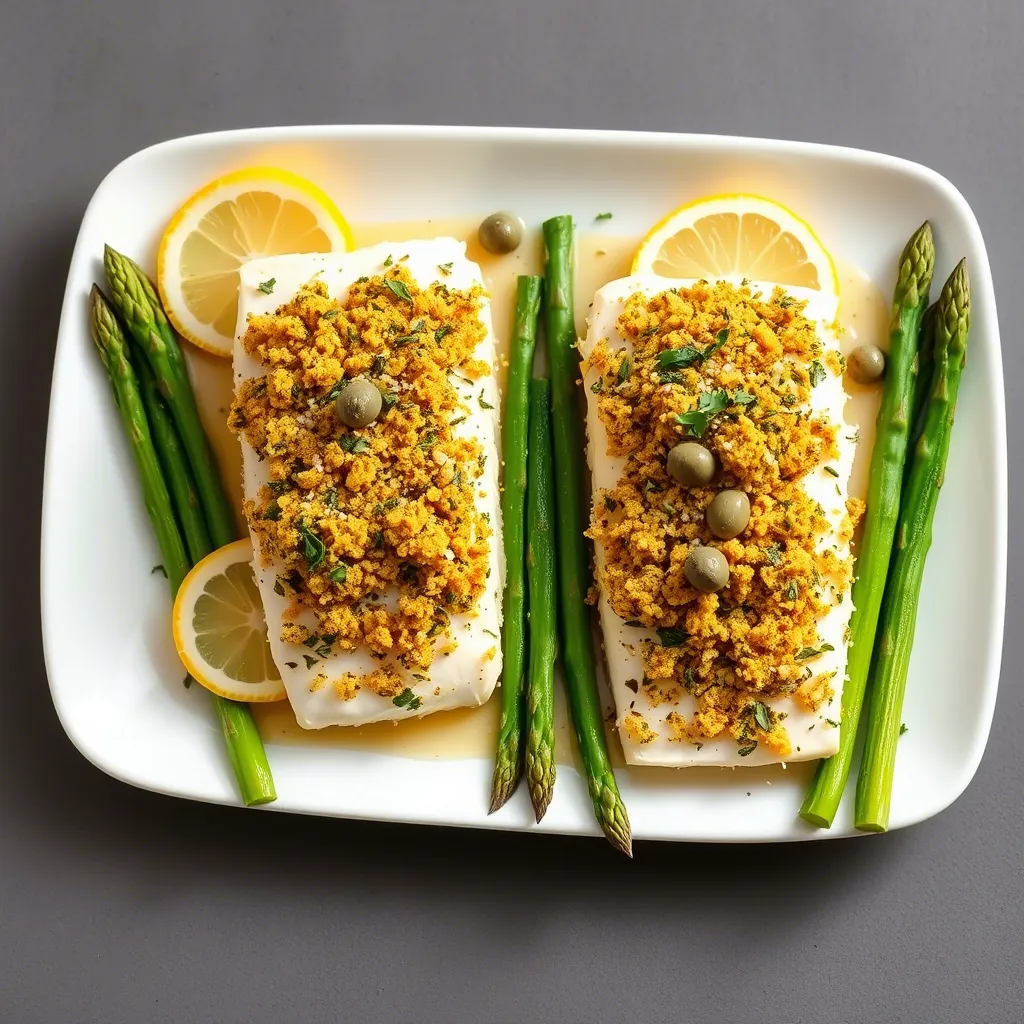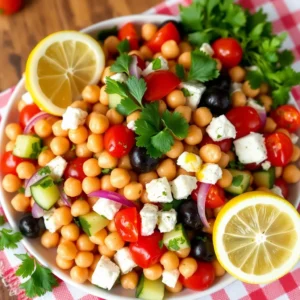Why You’ll Love This Garlic Lemon Herb Baked Fish
Oh, hello there! There’s something magical about the aroma of garlic, lemon, and fresh herbs wafting through the kitchen, isn’t there? Let me tell you why this herb baked fish recipe is about to become your new weeknight hero. As a busy mom or working professional, I know your evenings can feel like a three-ring circus – juggling homework help, household chores, and somehow getting a nutritious dinner on the table before everyone turns into hangry monsters!
That’s where this garlic lemon herb baked fish swoops in to save the day. In just 35 minutes total (and only 15 of those actually require your attention), you’ll have a restaurant-worthy dinner that looks like you spent hours in the kitchen. Talk about having your cake and eating it too – or in this case, your perfectly flaky fish!
What I love most about this recipe is how it transforms simple ingredients into something truly special. The bright zesty lemon cuts through the richness of the fish, while the garlic and herbs create a symphony of flavors that dance across your taste buds. Even my fish-skeptical 9-year-old asks for seconds when this hits the table!
For those of you trying to incorporate more seafood into your diet (we all know we should be eating more of it!), this recipe makes it absolutely painless. The mild white fish soaks up all those gorgeous flavors without tasting “too fishy” – the number one complaint I hear from reluctant seafood eaters.
And let’s talk about that gorgeous asparagus side! Roasting it alongside the fish not only saves you from washing another pan (you’re welcome!) but allows the vegetables to soak up all that wonderful garlicky, lemony goodness. It’s spring on a plate, folks! If you’re looking for other ways to enjoy spring vegetables, you might want to check out my Pasta Primavera recipe – another seasonal favorite in our household.
The beauty of this dish lies in its versatility. Having unexpected guests? This dish looks impressive enough for company. Need to accommodate different dietary needs? It’s naturally gluten-free, low-carb, and packed with protein. Plus, you can easily scale it up or down depending on how many mouths you’re feeding.
Remember those nights when you’re standing in front of the open fridge at 5:30 pm with absolutely no idea what to make for dinner? Consider this recipe your new back-pocket solution. It requires minimal ingredients that you probably already have on hand, and it pairs beautifully with whatever starch you have available – rice, potatoes, quinoa, or just a good crusty bread to soak up those heavenly juices.
The Story Behind This Garlic Lemon Herb Baked Fish
Would you believe this recipe was born out of a vacation disaster? Several years ago, my family rented a little cottage by the sea for a week-long summer break. I had grand plans of lazy beach days, evening walks along the shore, and plenty of seafood feasts. The weather, however, had other ideas.
On our third day, a storm rolled in that was so fierce it kept us housebound for nearly 48 hours. The kids were going stir-crazy, my husband was glued to weather reports, and I was desperately trying to maintain some semblance of vacation vibes despite the rain lashing against the windows.
The cottage had a tiny kitchen with minimal equipment and even fewer ingredients. I had purchased some fresh fish from a local market before the storm hit, planning to grill it outdoors (ha!). With outdoor cooking no longer an option and limited resources, I had to get creative.
I found a half-used lemon in the fridge, some garlic cloves rolling around in a bowl on the counter, and a small pot of herbs growing on the windowsill – likely left by previous vacationers. The only vegetable I had was a bunch of asparagus that needed to be used quickly.
With nothing else to do but make the best of our confinement, I decided to get the kids involved in creating dinner. They helped crush the garlic, pick the herbs, and arrange the asparagus around the fish. My daughter squeezed the lemon juice with such enthusiasm that we all got a little spritz! Those little moments of laughter were exactly what we needed on that gloomy day.
When I pulled that baking dish from the oven, something magical had happened. The storm outside was still raging, but our little cottage was filled with the most mouthwatering aroma. We sat down to what my husband now refers to as “the silver lining dinner” – the unexpected highlight of our rain-soaked vacation.
The fish was flaky and tender, infused with bright citrus and fragrant herbs. The asparagus had caramelized just enough to bring out its natural sweetness. We ate by candlelight (partly for ambiance, partly because I was worried about power outages), and for a little while, we forgot all about the storm.
Every time I make this dish now, it reminds me that sometimes the best recipes come from improvisation and making the most of what you have. It’s become our family’s go-to “comfort seafood” – a reminder that even in life’s stormy moments, there’s always the possibility of creating something wonderful.
My kids, now teenagers, still ask for “vacation fish” when they’ve had a rough day at school or when we need a little pick-me-up. It’s funny how food becomes woven into our family narratives, isn’t it? A simple dish born of necessity has become a symbol of resilience and finding joy in imperfect circumstances.
Ingredients
Let’s gather everything we need for our garlic lemon herb baked fish with asparagus! The beauty of this recipe lies in its simplicity – quality ingredients allowed to shine with minimal fuss.
For the fish:
- 4 white fish fillets (about 6 oz each) – cod, halibut, or tilapia work beautifully here, but use whatever looks freshest at your market. If you’re not sure what to choose, don’t be shy about asking the fishmonger for recommendations! The ideal thickness is about 1-inch; if your fillets are thinner, you’ll need to reduce the cooking time accordingly.
- 3 tablespoons olive oil – Use a good quality extra virgin olive oil here. Since we’re not cooking at extremely high temperatures, the nuanced flavors of a nicer oil will come through in the finished dish. That said, don’t feel you need to break out the super fancy bottle you’re saving for special occasions!
- 4 cloves garlic, minced – Fresh is non-negotiable here, folks! Those jars of pre-minced garlic just won’t deliver the same punch. If you’re in a time crunch, use a garlic press rather than reaching for shortcuts.
- 2 lemons – We’ll use the zest of one lemon and the juice of both. When selecting lemons, look for ones that feel heavy for their size and have a bright, aromatic scent when you scratch the peel slightly.
- 2 tablespoons fresh herbs, chopped – This is where you can really make the recipe your own! Dill, parsley, thyme, and chives are all wonderful options. My personal favorite combination is equal parts dill and parsley with a pinch of thyme. If fresh herbs aren’t available, you can substitute dried herbs, but reduce the quantity to 2 teaspoons total, as dried herbs are more potent.
- 1 teaspoon salt – I prefer kosher salt for its clean taste and easy-to-control texture, but table salt works fine too.
- 1/2 teaspoon freshly ground black pepper – Pre-ground pepper sits in those containers losing flavor by the minute. A few twists of your pepper mill makes all the difference!
- Optional: 1/4 teaspoon red pepper flakes – For those who enjoy a gentle kick of heat.
For the asparagus:
- 1 bunch fresh asparagus (about 1 pound) – Look for stalks of medium thickness with tight, closed tips. Very thin asparagus might overcook by the time the fish is done, while extremely thick stalks might need a head start in the oven.
- 1 tablespoon olive oil
- 1/2 teaspoon salt
- 1/4 teaspoon black pepper
- Optional: 2 tablespoons grated Parmesan cheese – This adds a lovely nutty finish to the asparagus, but the dish is still wonderful without it if you’re avoiding dairy.
For serving:
- Lemon wedges – Always include extra lemon for serving; a fresh squeeze right before eating brightens everything up!
- Additional fresh herbs for garnish
- Optional: 2 tablespoons capers, drained – These little flavor bombs add a wonderful briny pop that complements the fish beautifully.
Now, let’s talk substitutions because we all know that sometimes the pantry situation isn’t ideal:
Can’t find fresh herbs? While fresh is best for this recipe, you can use dried herbs in a pinch. Just remember the 3:1 ratio – 1 teaspoon dried herbs equals about 3 teaspoons (or 1 tablespoon) of fresh.
No lemons? In truly desperate times, bottled lemon juice can work for the liquid component (though you’ll miss out on the aromatic oils in the zest). You might also try orange or lime for a different but still delicious twist.
Asparagus out of season? Green beans, broccoli, or cherry tomatoes can all be roasted alongside the fish with equally delicious results. If using broccoli, cut it into smallish florets so it cooks in the same time as the fish.
Fish alternatives? This marinade works beautifully with chicken breasts as well, though you’ll need to adjust the cooking time (about 25-30 minutes for boneless chicken breasts).
Execution
Now comes the fun part – bringing our garlic lemon herb baked fish to life! The process is straightforward, but I’ll share all my little tricks for perfect results every time.
- Preheat your oven to 400°F (200°C). This temperature is the sweet spot for fish – hot enough to cook quickly without drying out the delicate flesh.
- Prepare the baking dish by lightly coating a 9×13 inch baking dish with a tiny bit of olive oil or a quick spritz of cooking spray. This prevents sticking and makes cleanup much easier.
- Prepare the asparagus by washing it thoroughly and patting dry with a clean kitchen towel. The drier the asparagus, the better it will roast instead of steam. Snap or cut off the woody ends – about 1-2 inches from the bottom. A neat trick is to bend each stalk gently until it naturally breaks at the point where the woody part ends!
- Arrange the asparagus in a single layer along the outer edges of the baking dish, leaving the center open for the fish. Drizzle with 1 tablespoon olive oil and sprinkle with 1/2 teaspoon salt and 1/4 teaspoon pepper. Toss gently to coat, then spread out again.
- Pat the fish fillets dry with paper towels. This step is crucial! Excess moisture on the fish will cause it to steam rather than bake properly and can dilute those wonderful flavors we’re about to add.
- Place the fish fillets in the center of the baking dish, nestled among the asparagus. If the fillets are uneven in thickness, fold the thinner ends underneath to create pieces of relatively uniform thickness. This helps everything cook evenly.
- In a small bowl, prepare our flavor powerhouse: combine 3 tablespoons olive oil, minced garlic, lemon zest (from one lemon), juice of one lemon (about 2-3 tablespoons), chopped fresh herbs, 1 teaspoon salt, 1/2 teaspoon pepper, and red pepper flakes if using. Whisk together until well blended. Take a moment to appreciate this gorgeous, fragrant mixture – this is where the magic happens!
- Pour this mixture evenly over the fish and asparagus, making sure each fillet gets a generous coating. Use a spoon to drizzle some of the mixture into any nooks and crannies.
- If you have a couple extra minutes, let this sit for about 10 minutes to allow the flavors to start penetrating the fish. If you’re in a rush, you can skip this step – the result will still be delicious.
- Slice the remaining lemon into thin rounds and arrange them over the fish fillets. This not only adds more lemon flavor but also helps keep the fish moist during baking. Plus, it looks beautiful!
- Bake in the preheated oven for 18-20 minutes, or until the fish flakes easily with a fork. The exact time will depend on the thickness of your fillets. For a foolproof method, insert an instant-read thermometer into the thickest part of a fillet – it should register 145°F (63°C).
- If you’re adding Parmesan to the asparagus, sprinkle it over the vegetables during the last 2 minutes of baking time.
- Remove from the oven and let rest for 2-3 minutes. This brief resting period allows the juices to redistribute throughout the fish, resulting in a moister final product.
- If using capers, scatter them over the dish now.
- Garnish with additional fresh herbs and serve with extra lemon wedges on the side.
The visual cues for doneness are important to note: perfectly cooked fish should be opaque and flake easily when prodded with a fork, but still look moist. If it appears dry or is falling apart too easily, it’s likely overcooked. The asparagus should be tender but still have a slight bite to it – no one enjoys mushy vegetables!
For more inspiration on perfectly roasted vegetables, check out my Perfectly Roasted Golden Potatoes recipe. The principles of great roasting apply across many vegetables!
As Serious Eats explains in their guide to cooking fish, the proteins in fish are more delicate than in meat, which is why overcooking happens so quickly. Their recommendation of using a gentle heat and watching carefully aligns perfectly with our baking method here.
Additional Tips
Let’s take your garlic lemon herb baked fish from great to absolutely stellar with these extra pointers and variations!
First, let’s talk timing. For busy weeknights, you can prep components ahead: clean and trim the asparagus, mix the herb-garlic-lemon sauce, and store them separately in the refrigerator. When dinner time rolls around, all you’ll need to do is arrange everything in the baking dish and pop it in the oven. Talk about a game-changer for those chaotic evenings!
Fish selection is crucial for this recipe. While I’ve recommended cod, halibut, or tilapia, don’t be afraid to experiment with what looks freshest at your market. Fresh fish should never smell “fishy” – instead, it should have a clean, oceanic scent. The eyes should be clear (if buying whole fish), and the flesh should be firm and spring back when touched. If you’re not confident in selecting fish, befriend your local fishmonger – their expertise is invaluable!
Let’s address the elephant in the room – fishy smells in the kitchen. To minimize lingering odors, make sure your fish is as fresh as possible. After cooking, simmer a pot of water with lemon slices and cinnamon sticks for about 10 minutes – it works wonders for clearing the air! Also, take out the trash promptly after disposing of any fish packaging.
For entertaining, this dish scales beautifully. For a larger crowd, simply use a larger baking dish (or two) and increase the ingredients proportionally. The cooking time remains roughly the same unless you’re using significantly thicker fillets.
Now, let’s talk variations to keep this recipe exciting every time you make it:
Mediterranean twist: Add halved cherry tomatoes, Kalamata olives, and crumbled feta cheese to the dish before baking. The tomatoes will burst in the oven, creating a delicious sauce.
Asian-inspired: Swap the herbs for minced ginger and green onions, add a splash of soy sauce and sesame oil to the marinade, and garnish with toasted sesame seeds.
Creamy version: After baking, drizzle the finished dish with a quick sauce made from Greek yogurt, lemon juice, and the same herbs you used in the marinade.
Spicy kick: Double the red pepper flakes and add a minced jalapeño to the garlic mixture for those who enjoy heat.
Breadcrumb topping: Mix panko breadcrumbs with melted butter, lemon zest, and chopped herbs, then sprinkle over the fish during the last 5 minutes of baking for a crispy contrast to the tender fish.
Storage and leftovers deserve special attention. While this dish is at its absolute best fresh from the oven, leftovers can be refrigerated for up to 2 days in an airtight container. To reheat without drying out the fish, place it in a 275°F oven, covered with foil, just until warmed through (about 10-15 minutes).
Here’s a clever leftover transformation: flake the cold fish and mix with a bit of mayonnaise, fresh herbs, and lemon juice for an incredible sandwich filling or salad topper the next day. Waste not, want not!
For those watching their calories, you can reduce the olive oil to 2 tablespoons total without significantly impacting the flavor. The dish will still be delicious, just slightly less rich.
Got picky eaters at home? Try these tricks: for children who think they don’t like fish, let them help prepare the meal (kids are more likely to eat what they’ve helped cook), use milder white fish like cod or tilapia, and serve with a familiar side like rice or roasted potatoes alongside the asparagus.
Speaking of sides, while this dish is complete with the asparagus, you might want to add a starch depending on your hunger level or preference. Fluffy couscous, crusty bread, or a simple rice pilaf all make excellent companions to soak up those delicious juices.
For a stunning presentation that’s dinner-party worthy, try serving the fish and asparagus over a bed of Cilantro Lime Rice – the vibrant colors and contrasting flavors create a restaurant-quality plate that will impress any guest!
According to Food Network’s guide on sustainability, opting for sustainably sourced fish is not only better for the environment but often results in fresher, better-tasting seafood. Look for Marine Stewardship Council (MSC) certification or ask your fishmonger about sustainable options available in your area.
FAQs
Can I use frozen fish for this garlic lemon herb recipe?
Absolutely! Just make sure to thaw it completely and pat it very dry before proceeding with the recipe. Frozen fish often releases extra moisture during cooking, so you might want to let it sit with salt for 5 minutes, then pat dry again before adding the herb mixture. This helps achieve that perfect texture we’re looking for in our spring dinner entrée.
How do I know when the fish is properly cooked?
The fish should flake easily with a fork but still appear moist. If you have an instant-read thermometer, the internal temperature should reach 145°F (63°C). Visual cues are important too – the fish should change from translucent to opaque throughout. Overcooking is the most common mistake with fish, so start checking a few minutes before the suggested cooking time, especially if your fillets are on the thinner side.
My family doesn’t like asparagus. What are some good substitutes?
You have plenty of options! Green beans, broccoli florets, cherry tomatoes, zucchini slices, or bell pepper strips all work wonderfully in this recipe. Choose vegetables with similar cooking times to ensure everything is perfectly done together. If using harder vegetables like carrots, consider giving them a 5-10 minute head start in the oven before adding the fish.
Can I make this recipe dairy-free and gluten-free?
Great news – this recipe is naturally gluten-free as written! To keep it dairy-free, simply omit the optional Parmesan cheese on the asparagus. The dish is so flavorful with the lemon garlic combination that you won’t miss it. This makes it perfect for accommodating various dietary needs without requiring special ingredients or significant recipe modifications.
What herbs work best with this lemon garlic fish dish?
The beauty of this recipe is its flexibility with herbs! Dill and parsley are classic pairings with fish and lemon. Thyme and rosemary offer a more aromatic profile but use them more sparingly as they’re quite potent. Chives add a gentle onion note that complements without overpowering. For a more Mediterranean flair, oregano works beautifully. Feel free to create your own signature herb blend based on what you have in your garden or what looks freshest at the store.
How can I add more flavor if I’m reducing salt for dietary reasons?
If you’re watching your sodium intake, increase the herbs by 50% and double the lemon zest (not the juice, as too much acid can make the fish tough). A pinch of white pepper adds complexity without salt. Garlic can also be increased for more punch. Another great trick is to finish the dish with a tiny drizzle of high-quality olive oil just before serving – it adds richness that can make you forget about the reduced salt.
Can this herb baked fish recipe be prepared in advance for a dinner party?
Yes, with some modifications! Prepare the herb-garlic-lemon mixture up to 24 hours in advance and refrigerate it. Clean and trim the asparagus ahead of time too. About 30 minutes before guests arrive, arrange everything in the baking dish but don’t add the herb mixture until right before it goes into the oven. This preparation strategy gives you the fresh-cooked flavor and texture while eliminating last-minute stress – perfect for entertaining!
As we wrap up this culinary journey, remember that this garlic lemon herb baked fish recipe is more than just a meal – it’s an opportunity to create a moment of brightness in your day, regardless of how hectic life gets. The gentle mingling of citrus, herbs, and garlic transforms simple ingredients into something truly special, proving once again that good food doesn’t need to be complicated.
Whether you’re cooking for a quiet weeknight dinner, impressing weekend guests, or teaching little ones about the joys of seafood, this dish delivers both nourishment and pleasure in equal measure. The tender fish, vibrant asparagus, and zesty sauce come together in a harmony that’s greater than the sum of its parts – the hallmark of truly good cooking.
So the next time you’re standing in front of your refrigerator wondering what to make for dinner, remember this herb baked fish recipe. In just 35 minutes, you can transport your table to a place where flavors are bright, meals are satisfying, and even the busiest days end on a delicious note.
Until next time, happy cooking!



